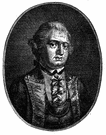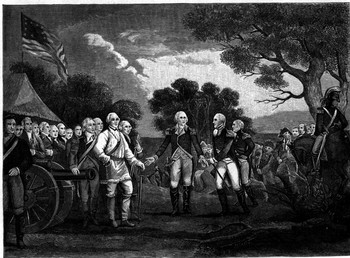|
|

The American Victory at Saratoga
|

|
|
Share This Page
|
|
|
|
|
|
|
Follow This Site

|
 |
|
|
|
|

|
Part 2: Changing the World Order
St. Leger, meanwhile, was having a tough time of it as well. He had chosen to begin a siege of Fort Stanwix, on the Mohawk River. St. Leger was successful at first, but a relief force led by American General Benedict Arnold managed to convince St. Leger that time had come to abandon what to him must have seemed a foolhardy mission and return to the friendly confines of Canada.
Burgoyne, not knowing any of this until much later, continued on toward Albany, his force reduced to 6,000 through a combination of defeats, disease, and desertions. When Burgoyne reached the outskirts of  Saratoga in mid-September, he saw before him a Colonial army numbering more than 8,000 men and commanded by General Horatio Gates. Burgoyne tried to catch Gates by surprise by sending a stealthy force to outflank him, but Gates was ready. Nothing came of the stealthy plan, and both sides settled down for the main event. Saratoga in mid-September, he saw before him a Colonial army numbering more than 8,000 men and commanded by General Horatio Gates. Burgoyne tried to catch Gates by surprise by sending a stealthy force to outflank him, but Gates was ready. Nothing came of the stealthy plan, and both sides settled down for the main event.
It was about this time that reinforcements under Howe were supposed to be arriving from New York City. Howe, however, being a bit of his own man and thinking that Burgoyne didn't exactly want to share the glory that the Saratoga victory would bring, decided to go off on his own. He wanted no part of the Albany endeavor; instead, Howe wanted what he considered a great prize—Philadelphia, the capital of the American Colonies at that time. (He did just that, taking control of the city on September 26.)
A detachment of British soldiers under General Henry Clinton did sail up the Hudson River and did do some major damage, including burning the Colonial Army Capital at Kingston; but it wasn't nearly enough, and he didn't arrive until way too late.
By October, the Colonial Army at Saratoga was very large indeed, numbering about 11,000, nearly twice that of Burgoyne's. The British general was firmly convinced by this time that help was indeed not coming. He had no doubt received messages from St. Leger, Howe, and Clinton and determined that he was on his own. With no way out, he chose to fight.
 The battle began on October 7 and lasted a full 10 days (much longer than the Americans probably had anticipated). Charge followed charge, counterattack followed attack, and the result was the smashing American victory that Washington, Gates, and all the other American generals had been hoping for for a few years. Burgoyne surrendered himself and his entire force, giving up claims to New York and abandoning his great quest to remove New England from the American sphere of influence. The battle began on October 7 and lasted a full 10 days (much longer than the Americans probably had anticipated). Charge followed charge, counterattack followed attack, and the result was the smashing American victory that Washington, Gates, and all the other American generals had been hoping for for a few years. Burgoyne surrendered himself and his entire force, giving up claims to New York and abandoning his great quest to remove New England from the American sphere of influence.
News of the American victory traveled quickly. General George Washington, himself newly ousted from Philadelphia, was overjoyed and sent his hearty congratulations to Gates. American ambassadors to other European countries made sure that the monarchs of those countries—particularly France, Spain, and Holland—knew about the victory. These three countries, frequent opponents of Great Britain in the past, jumped at the chance to fight Britain again. Soon, all three were sending money, weapons, and men to fight on the American side.
 The war continued for another four years, of course, even with the assistance of the European powers. And end-of-war treaty negotiations dragged on for two years after that. But it was after Saratoga that the heads of state of Europe, France especially, sat up and took notice of the upstart Colonial Army, seeing in the great victory at Saratoga the potential to win even more great victories and maybe even defeat the British Army once and for all. The war continued for another four years, of course, even with the assistance of the European powers. And end-of-war treaty negotiations dragged on for two years after that. But it was after Saratoga that the heads of state of Europe, France especially, sat up and took notice of the upstart Colonial Army, seeing in the great victory at Saratoga the potential to win even more great victories and maybe even defeat the British Army once and for all.
First page > Setting the Scene > Page 1, 2 |
|



 Saratoga in mid-September, he saw before him a Colonial army numbering more than 8,000 men and commanded by
Saratoga in mid-September, he saw before him a Colonial army numbering more than 8,000 men and commanded by  The battle began on October 7 and lasted a full 10 days (much longer than the Americans probably had anticipated). Charge followed charge, counterattack followed attack, and the result was the smashing American victory that Washington, Gates, and all the other American generals had been hoping for for a few years. Burgoyne surrendered himself and his entire force, giving up claims to New York and abandoning his great quest to remove New England from the American sphere of influence.
The battle began on October 7 and lasted a full 10 days (much longer than the Americans probably had anticipated). Charge followed charge, counterattack followed attack, and the result was the smashing American victory that Washington, Gates, and all the other American generals had been hoping for for a few years. Burgoyne surrendered himself and his entire force, giving up claims to New York and abandoning his great quest to remove New England from the American sphere of influence. The war continued for another four years, of course, even with the assistance of the European powers. And end-of-war treaty negotiations dragged on for two years after that. But it was after Saratoga that the heads of state of Europe, France especially, sat up and took notice of the upstart Colonial Army, seeing in the great victory at Saratoga the potential to win even more great victories and maybe even defeat the British Army once and for all.
The war continued for another four years, of course, even with the assistance of the European powers. And end-of-war treaty negotiations dragged on for two years after that. But it was after Saratoga that the heads of state of Europe, France especially, sat up and took notice of the upstart Colonial Army, seeing in the great victory at Saratoga the potential to win even more great victories and maybe even defeat the British Army once and for all.
